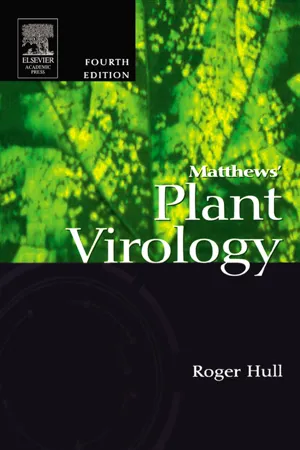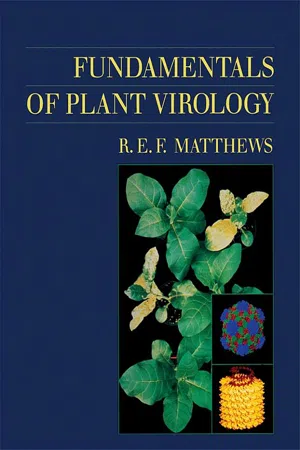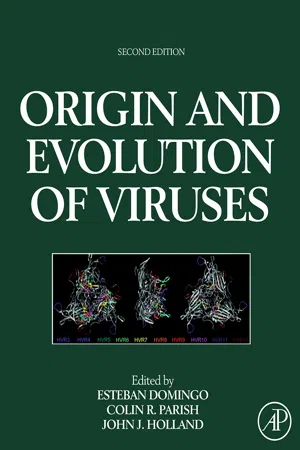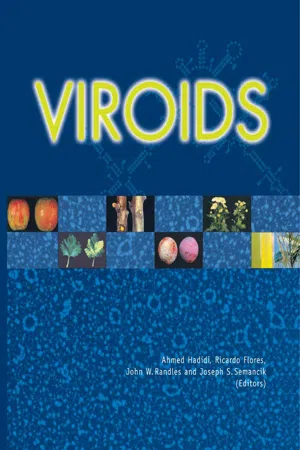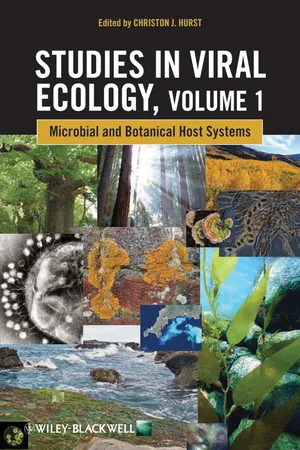Biological Sciences
Viroid
Viroids are small, single-stranded, circular RNA molecules that are infectious and can cause disease in plants. Unlike viruses, viroids do not encode any proteins and rely on host cellular machinery for replication. They are known for their ability to disrupt normal plant growth and development, making them a significant concern in agriculture and horticulture.
Written by Perlego with AI-assistance
Related key terms
Related key terms
1 of 4
Related key terms
1 of 3
7 Key excerpts on "Viroid"
- eBook - ePub
Plant Viruses
Volume I: Structure and Replication
- C.L. Mandahar(Author)
- 2018(Publication Date)
- CRC Press(Publisher)
Chapter 8 Plant Viroids: A Biochemical NoveltyR. P. SinghTable of Contents
I. Introduction II. Viroid Diseases A. Pathological Significance B. Discovery of Viroid Nature C. The Viroid Diseases Reported to Date D. Origin of Viroid Diseases E. Transmission and Spread of Viroid Diseases F. Viroid Isolation and Maintenance G. Viroid Detection by Biochemical Methods III. Biophysical Nature of Viroids A. Purification B. Infectivity of Linear and Circular Viroid Molecules C. Electron Micrograph of Viroid Molecules D. RNA Sequencing — Methods E. Primary Structure and Viroid Groups F. RNA Sequence Variability of Viroid Isolates G. RNA Sequences — Secondary and Tertiary Structures H. Structural Transitions of Viroid Molecules I. In Vivo Structures of Viroids IV. Replication A. Absence of Translational Products B. Existence of Oligomeric Complementary RNAs C. Enzymes Involved in Viroid Replication D. Nonenzymatic Cleavage of Oligomers E. Models of Replication F. Replication Sites V. Pathogenicity A. Nucleotide Sequence Comparison of Variant Isolates B. Infectivity of cDNA and RNA Transcripts C. Site-Specific Mutations in cDNAs D. Infectivity of Viroid cDNA Chimeras VI. Speculations on the Possible Origin of Viroids A. Presequence Hypotheses — A Historical Preview B. The Present-Day Concept — The Intron Connection Acknowledgments References I. Introduction
Viroids are low-molecular weight1 , 2 covalently closed circular RNA3 molecules that can cause economically important diseases of higher plants.4 - 6 Viroids are distinguished from viruses by the absence of a protein coat, lack of mRNA activity, and by the homogenous structure, structural transitions, and hydrodynamic behavior of their RNA molecules.7 - 10 If one could rephrase the expression "small is beautiful" to include "complex and mysterious" that would describe the Viroids.II. Viroid Diseases
- eBook - ePub
- Roger Hull(Author)
- 2001(Publication Date)
- Academic Press(Publisher)
CHAPTER 14Viroids, Satellite Viruses and Satellite RNAs
There are various small RNAs associated with plant pathogenic situations. Essentially, most fall into two groups: those that can replicate autonomously and those that require a functional virus for their replication. The former group is termed Viroids and the latter include satellites and defective nucleic acids. Defective nucleic acids are described in Chapter 8 (Section IX.C ). In this chapter, I will describe Viroids and satellites.I. ViroidS
Various important virus-like diseases in plants have been shown to be caused by pathogenic RNAs known as Viroids, a term first introduced by Diener (1971) to describe the infectious agent causing the spindle tuber disease of potato. They are small circular molecules, a few hundred nucleotides long, with a high degree of secondary structure. They do not code for any polypeptides and replicate independently of any associated plant virus. Viroids are of practical importance as the cause of several economically significant diseases and are of general biological interest as being among the smallest known agents of infectious disease. Work on Viroids has been reviewed many times, for example by Diener (1987b) , Diener (1993) ,Flores et al. (1997), Symons (1997) and Diener (1999) . The most studied Viroid is potato spindle tuber Viroid (PSTVd). Viroid names are abbreviated to initials with a ‘d’ added to distinguish them from abbreviations for virus names. Acronyms for Viroids are listed in Appendix 1 - eBook - ePub
- R C Matthews(Author)
- 2012(Publication Date)
- Academic Press(Publisher)
They are small circular ssRNA molecules a few hundred nucleotides long, with a high degree of secondary structure. They do not code for any polypeptides, and replicate independent of any associated plant virus. Indeed there is no evidence to show that Viroids are related to viruses in an evolutionary sense. Viroids are of practical importance as the cause of several economically significant diseases, and are of general biological interest as the smallest known agents of infectious disease. The most-studied Viroid is potato spindle tuber Viroid (PSTVd). Viroid names are abbreviated to the initials with d added to distinguish Viroid from abbreviations for virus names (Appendix 1, Table 2). 1.1 STRUCTURE OF ViroidS 1.1.1 Circular Nature of Viroid RNA The circular nature of many Viroids was first shown directly by electron microscopy. Under nondenaturing conditions, the molecules appear as small rods with an axial ratio of about 20:1, and for PSTVd, an average length of about 37 nm. Spread under denaturing conditions, the molecules can be seen to be covalently closed circles. All Viroid preparations also contain a variable proportion of linear molecules. 1.1.2 Nucleotide Sequences The nucleotide sequences of about 50 Viroids and Viroid sequence variants are now known. These sequences have confirmed the circular nature of the molecules (Fig. 9.1). All Viroids have some degree of sequence similarity. On the basis of degree of overall sequence similarity, 16 distinct Viroids have been recognized, and other distinct Viroids continue to be discovered. The use of copy DNA (cDNA) clones to sequence field isolates of Viroids has revealed that a single isolate may contain a range of closely related sequence variants. Figure 9.1 Potato spindle tuber Viroid. (A) Nucleotide sequence as determined by Gross et al. (1978). (B) Proposed secondary structure in outline. (C) Three-dimensional representation of the Viroid molecule. Courtesy of H - eBook - ePub
Innovative Approaches in Diagnosis and Management of Crop Diseases
Volume 1: The Mollicutes
- Rakesh Kumar Singh, Gopala, Rakesh Kumar Singh, Gopala(Authors)
- 2021(Publication Date)
- Apple Academic Press(Publisher)
CHAPTER 2Techniques for Detection of ViroidsPANKHURI SINGHAL,1 MANOJ K. YADAV,2 and SAJAD UN NABI31 Division of Plant Pathology, ICAR-Indian Agricultural Research Institute, New Delhi–110012, India, E-mail: [email protected]2 ICAR-National Rice Research Institute, Cuttack–753006, Odisha, India3 ICAR-Central Institute of Temperate Horticulture, Srinagar–191132, Jammu and Kashmir, IndiaABSTRACT
Viroids are the smallest RNA pathogens that infect and replicate autonomously in higher plants. They exist as circular, single-stranded, non-coding RNA with a length of 246–401 nucleotides. They do not code any peptides; hence they rely entirely on host factors for their replication. Broadly Viroids are classified into two families, i.e., the PospiViroidae family, whose members replicate in the nucleus and contain five conserved structural/functional domains, and the AvsunViroidae family members replicate in chloroplast and exhibit ribozyme activity. Viroid hosts include both herbaceous and woody species. More than 40 Viroid diseases have been reported from different plant species. Symptoms of Viroid infection include stunting, leaf epinasty and distortion, fruit distortion and color break, stem, and leaf necrosis, and even death of the whole plant, and they are often dependent upon environmental conditions. Viroids were initially identified by their association with specific diseases, but not all Viroid-infected plants exhibit obvious signs of disease. Identification of Viroid-infected plants can be accomplished by either symptomatology on indicator hosts, a classical method still used in many certification programs. Due to a lack of protein coat, protein-based diagnostics are not valid. Diagnostics thus is limited to: (a) bioassay on sensitive hosts; (b) polyacrylamide gel electrophoresis (PAGE); (c) nucleic acid spot hybridization (NASH); (d) reverse transcription-polymerase chain reaction (RT-PCR). More recently developed methods such as micro-and macroarrays, next-generation sequencing (NGS), enable even faster and more sensitive detection of Viroid infections. On-site detection is also an important improvement of detection techniques, since it facilitates the adoption of fast measures to prevent potential disease spread. Isothermal amplification methods like reverse transcriptase-loop mediated isothermal amplification (RT-LAMP), recombinase polymerase amplification (RPA) has also been used for Viroid detection. - eBook - ePub
- Esteban Domingo, Colin R. Parrish, John J. Holland(Authors)
- 2008(Publication Date)
- Academic Press(Publisher)
et al., 2004). More specifically, Viroids could have evolved their secondary structure as a compromise between resistance to DCL and RISC, which act preferentially against RNAs with compact and relaxed secondary structures, respectively, although subcellular compartmentation, association with host proteins, or active replication could also help Viroids to elude their host RNA-silencing machinery.Viroid EPIDEMIOLOGY
The present understanding of Viroid epidemiology in crop plants indicates that spread and persistence of these pathogens is mainly associated with the international exchange of germplasm, vegetative propagation of infected material, and agricultural practices that favor mechanical transmission. However, the hypothesis of the emergence of Viroid-like molecules from an early RNA world must be compatible both with their survival until the appearance of suitable host plants and with their perpetuation into such hosts. Perpetuation and evolution of Viroids within their initial hosts can only be explained through seed transmission, despite most Viroids having been identified in hosts grown as agricultural commodities in which seed transmission is infrequent. However, there are instances (PSTVd, CbVd-1, and ASBVd) in which seed transmission has been demonstrated (reviewed bySingh et al., 2003). In this context, ASBVd offers the most interesting example because symptomless carrier trees present an unusually high rate (95%) of seed transmission (Wallace and Drake, 1962 - eBook - ePub
Viroids
Properties, Detection, Diseases and their Control
- Ahmed Hadidi, Ricardo Flores, John W. Randles, Joseph S. Semancik(Authors)
- 2003(Publication Date)
- CSIRO PUBLISHING(Publisher)
On this basis, it was thought that their pathogenicity had to be exerted through direct interference with some critical cellular targets (Diener 1979 ; Semancik and Conejero 1987 ; Conejero et al. 1979). From this, and taking into account the replication and location of most Viroids in the nucleus (Riesner 1987 ; Robertson and Branch 1987 ; Sänger 1987), the obvious strategy was to look for possible interference of Viroid RNA molecules or their complementary replicative forms, with either host nucleic acids or proteins, as the primary pathogenic event. Thus, it was suggested that Viroids express their pathogenicity by altered regulation of gene expression (Rackwitz et al. 1981 ; Diener 1981 ; Dickson 1981 ; Solymosy and Kiss 1985) and altered translocation of proteins through base pairing with RNA signal recognition particles (Haas et al. 1988). These interpretations were supported by theoretical considerations. A different type of approach in our laboratory (Conejero and Granell 1986) led to evidence indicating that Viroids seem to be elicitors of a general response system of the host plant (Conejero et al. 1990). Very soon after the discovery of Viroids, any new finding or idea concerning the role of RNA in any of the steps of gene expression (transcription, RNA maturation, translation) and/or their regulation, has been used to help interpretation of Viroid pathogenicity. In the last decade the emergence of the new concept of gene silencing (GS), and its specific signaling by small RNA molecules, again could help to understand how Viroids produce developmental distortions and/or the plants defend themselves, specifically, against the systemic infection of Viroids - eBook - ePub
Studies in Viral Ecology, Volume 1
Microbial and Botanical Host Systems
- Christon J. Hurst, Christon J. Hurst(Authors)
- 2011(Publication Date)
- Wiley-Blackwell(Publisher)
Perhaps the time has come to suggest a fourth biological domain to give a higher taxonomic home to the viruses and their genomic relatives. One logical suggestion would be to include as a group the ‘conventional' viruses plus those satellite viruses whose genomes likewise code for their own structural ‘shell' or ‘capsid' proteins, and which are also commonly defined as ‘viruses'. A second group within this domain might consist of the Viroids, virusoids, and the viral genus Deltavirus, which share strong commonalities with respect to their RNA genomic structure and the fact that they do not code for such structural proteins. These infectious agents are excluded from the three existing domains for two reasons: first, their genomes do not code for ribosomal RNA which is the defining characteristic for membership in the three domains and second, they lack a cellular structure of their own, a fact which also kept them officially excluded from the older kingdom classifications.The conventional viruses are very heterogenous with respect to their genomic structure and vary widely in the extent of genetic coding that they carry. Some of them such as T4, a member of the family Myoviridae, carry a major amount of the genetic coding which is necessary to replicate themselves. Other viruses, such as the human polioviruses which belong to the family Picornaviridae, carry just barely more than the limited amount of genome needed to code for their structural proteins. In comparison, the RNA genomes of the Viroids and virusoids as a group are more homogenous and uniquely seem to evidence an evolutionary stability as infectious agents despite the fact that their genomes do not code for any such structural proteins. The variety of agents known as virusoids “borrow” encapsulating proteins from a helper virus. The Viroids either have done away with the need for encapsulating proteins or perhaps never possessed them. The genome of the Hepatitis D virus, which is the constituent species of the floating genus Deltavirus, represents what seems to be an interesting evolutionary anomaly. This agent of humans is essentially identical to that of the Viroids which are plant pathogens, with exception of the fact that the Hepatitis D virus' genome carrys the genetic coding for a protein that it apparently has picked-up from a cellular host (Brazas and Ganem, 1996; Robertson, 1996). Despite its very limited coding capacity, as with the virusoids, the hepatitis D virus needs to “borrow” enveloping structural proteins which are coded for by a helper virus.
Index pages curate the most relevant extracts from our library of academic textbooks. They’ve been created using an in-house natural language model (NLM), each adding context and meaning to key research topics.
Explore more topic indexes
Explore more topic indexes
1 of 6
Explore more topic indexes
1 of 4

